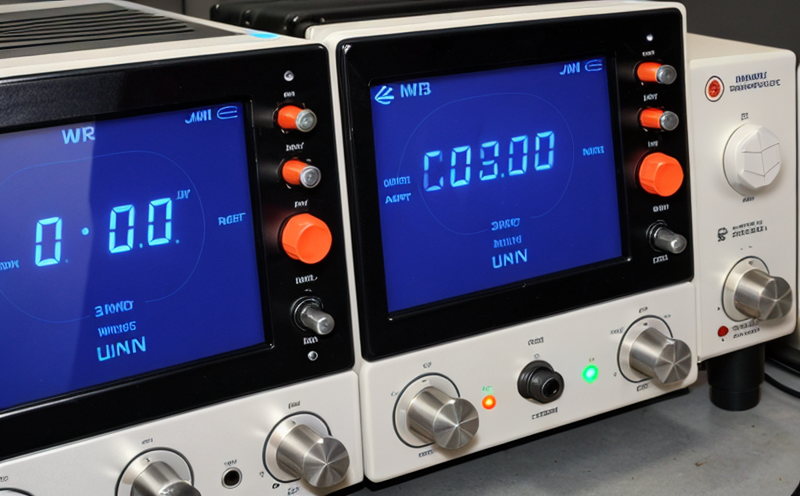ANSI/TIA-568 Wireless Structured Cabling RF Compliance Testing
The ANSI/TIA-568 standard is widely recognized as a benchmark for structured cabling systems in telecommunication environments. The wireless aspect of this standard, specifically focusing on RF (Radio Frequency) compliance testing, ensures that the cabling infrastructure supports reliable and secure wireless communication within buildings.
RF compliance testing encompasses various aspects including signal integrity, interference levels, and overall performance under different environmental conditions. This type of testing is crucial for ensuring that structured cabling systems meet the stringent requirements set by ANSI/TIA-568 for wireless communications.
The process involves a series of tests designed to evaluate how well the cabling system can handle wireless signals without degradation or interference. These tests are conducted using specialized equipment that simulates real-world conditions, such as background noise and signal strength variations. The goal is to ensure that the cabling infrastructure performs consistently across all frequency bands used by wireless devices.
For quality managers and compliance officers, this service provides critical insights into potential issues within their structured cabling systems before they become operational problems. R&D engineers can leverage these tests to refine product designs ensuring compatibility with existing standards while also preparing for future technological advancements. Procurement professionals benefit from this testing as it helps them identify suppliers who adhere strictly to industry best practices.
The importance of RF compliance cannot be overstated in today’s rapidly evolving smart home and IoT environments where seamless integration between various devices is essential. By adhering to ANSI/TIA-568 standards, organizations can ensure their cabling infrastructure remains robust against future challenges posed by increasing demands on bandwidth and interoperability.
Compliance with these standards also enhances security measures within networks by minimizing unauthorized access points through proper cabling placement and configuration. Properly designed and tested structured cabling systems contribute significantly towards creating secure, efficient communication pathways necessary for modern business operations and residential settings alike.
In summary, ANSI/TIA-568 Wireless Structured Cabling RF Compliance Testing is an indispensable service that ensures the reliability and security of wireless communication infrastructure. It plays a pivotal role in maintaining high standards of performance across all sectors relying heavily on structured cabling for their day-to-day operations.
Applied Standards
The ANSI/TIA-568 standard is one of the most comprehensive guidelines available today when it comes to structured cabling systems. It encompasses multiple parts addressing different aspects of cabling design, installation, and management. For wireless communication specifically, Part 7 deals with data center infrastructure management (DCIM), which includes provisions for RF environment monitoring.
When performing RF compliance testing according to ANSI/TIA-568 standards, laboratories follow specific procedures outlined in this document. These include setting up test environments that replicate real-world conditions as closely as possible so that any discrepancies or issues can be identified early on during the development stages of a project.
The standard specifies parameters such as frequency range, signal strength levels, and interference thresholds which serve as benchmarks against which actual performance metrics are measured. Compliance testing ensures that all components within the cabling system meet these requirements ensuring optimal operation regardless of environmental factors or varying load conditions.
Industry Applications
Smart homes and IoT devices rely heavily on structured cabling for seamless connectivity between various components. In such environments, RF compliance testing becomes even more critical due to the increased complexity introduced by multiple wireless protocols operating simultaneously. Ensuring that all devices operate within specified frequencies helps prevent interference while maintaining peak performance.
Healthcare facilities often implement robust wired networks supporting telemedicine applications and patient monitoring systems which require dependable data transfer rates. By adhering to ANSI/TIA-568 standards, healthcare providers can rest assured knowing their cabling infrastructure will support advanced medical technologies without compromising security or reliability.
Data centers host numerous servers and networking equipment requiring consistent power supply and low latency connections between devices. Properly configured and tested structured cabling ensures that data packets travel efficiently reducing downtime and enhancing overall service availability.
Education institutions benefit greatly from well-designed wired networks supporting multimedia presentations, video conferencing, and interactive learning platforms. RF compliance testing guarantees that these systems remain stable and responsive throughout extended periods of use without experiencing performance degradation.
Competitive Advantage and Market Impact
- Enhanced Reliability: Compliance with ANSI/TIA-568 standards ensures that structured cabling systems are built to last, providing long-term value for businesses investing in infrastructure upgrades.
- Increased Security: By minimizing unauthorized access points through proper cabling placement and configuration, organizations can significantly enhance their cybersecurity posture.
- Improved Performance: Rigorous testing according to these standards helps identify potential weaknesses early on allowing for corrective action before deployment.
- Future-Proof Solutions: Adhering to current industry best practices ensures that cabling infrastructure remains compatible with emerging technologies and protocols.
The demand for reliable structured cabling systems continues to grow as more industries recognize the importance of robust communication networks. Organizations that invest in ANSI/TIA-568 Wireless Structured Cabling RF Compliance Testing demonstrate their commitment to quality, reliability, and security – all key differentiators in today’s competitive market.





